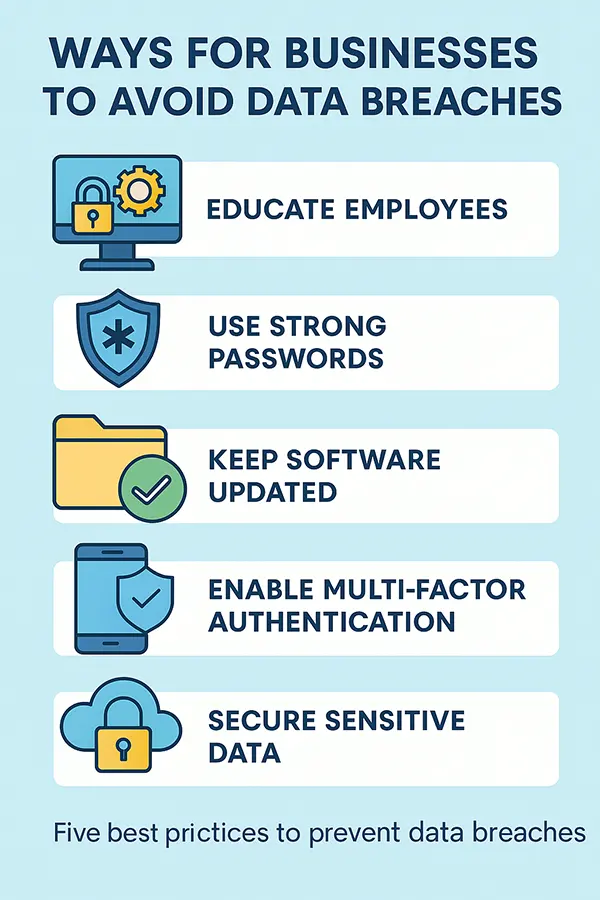Relying on yourself could result in an incomplete recovery of your systems. By using experts, there is a thorough cleanup of your system, savings in money, and you can be assured of thorough protection for the future.
KEY TAKEAWAYS
- Hiring professionals is more cost-effective than handling breaches by yourself.
- Delayed reporting worsens damage and risks legal or reputational consequences.
- Communicate breach details immediately across all departments for faster action.
- Lack of documentation hinders long-term recovery and future breach prevention.
According to the 2024 IBM Security Cost of a Data Breach Report, the average global data breach expenses have reached $4.88 million, an increase of 15% over the last 3 years.
Although most organizations are dedicated to avoiding security breaches, ultimately, far fewer have a plan defined for what happens next. A number of the errors and chaos that occur at the response stage caused by a breach can only amplify the problems.
This article will outline some of the most critical errors to avoid after a breach. By avoiding these potentially insidious mistakes, you can limit a breach’s damage, protect your reputation, and provide clearer direction for your team to respond to a breach, as 50% of businesses experience breaches.

One of the biggest mistakes that businesses make in the aftermath of a disaster is assuming that they can handle everything themselves. Business officials assume that hiring a professional disaster mitigation company is an additional transaction that they can’t afford in the aftermath of costly damage.
Handling recovery on your own can end up costing more than hiring professionals. The experts from https://cottongds.com/locations/orlando-fl recommend consulting professional damage restoration services after any disaster, from natural disasters to cybersecurity breaches. Working with the professionals is more cost-effective than attempting to handle the relief yourself.
Cybersecurity is complex, and even trained developers may struggle without specialized certification or focused expertise. Without the right knowledge, your team will not be able to eliminate all cybersecurity breaches, and the damage can stay in your system long after you think you’ve recovered.
When you work with professional disaster recovery teams, they will conduct a thorough overview of your system and find all potential breaches. This allows you to start recovery right away instead of prolonging the damage. Below, you can see the best way to protect your business from dada breaches.


Admitting that your business suffered a cybersecurity breach is embarrassing and may cause you to lose face with partners and customers. For that reason, many businesses try to avoid reporting the incident in favor of handling it quietly in-house.
However, delayed reporting can cost your business a lot in the long term. If you put off reporting a cybersecurity breach, you miss valuable response time during which cybersecurity experts could address the incident before it causes further damage. Delaying your response can lead to even more harm to your digital systems.
If you don’t report the incident on time, it could harm your business’s credibility. Cybersecurity breaches are hard to keep secret, and investors and customers will find out. If you try to cover up the incident, they will lose more trust in you than if you actually reported it on time. If suspected of hiding a breach, you could face negligence lawsuits.
When you notice a cybersecurity breach, the best thing to do is report it immediately. That is the only way to ensure a swift reaction, which will ameliorate the damage.
Most larger companies operate thanks to the division of labor. Different departments handle different aspects of running the business.
Even within the IT department or programming team, work is usually strictly divided between different groups and individuals. Some team members fix bugs, while others oversee parts of the digital infrastructure. Sometimes there are joint meetings to ensure everyone is on the same page, but usually people just do their own thing.
This way of doing business is good in normal situations because it promotes efficiency and ensures that everyone knows what to do. However, during emergencies like cybersecurity breaches, excessive segmentation can negatively impact your business.
Not communicating on time when there is an emergency prevents everyone from knowing the full picture of what is happening in the business. That means you can’t put together a comprehensive answer that fully addresses the threat, and are stuck only partially dealing with what damage you can find.
Any delays to your cybersecurity response will cause more expensive damage to your business, so communicating with everyone immediately when you notice a potential breach is vital. Create a clear protocol that your entire team understands before a cybersecurity breach happens. Make sure that all meetings related to cybersecurity preparation involve people from the whole company.

When a cybersecurity breach occurs, documentation may be the last thing on your mind. You want to get the problem fixed and fast rather than delaying with documenting and recording.
However, not prioritizing documentation can sabotage your incident responses in the long term. You want to have documentation in place so you can keep track of how the cybersecurity breach affected your digital infrastructure and which responses were effective. Without proper documentation, you’ll be navigating blindly after your initial response.
Having documentation on hand will also help you prepare for future cybersecurity breaches. Understanding how the breach happened, what damage it caused, and how it was contained can help you prepare for the future.
Lack of documentation prevents you from strengthening cybersecurity, leaving your systems exposed to future breaches. It will also sabotage your response to this incident because you won’t remember what you did at the beginning of the process.
Encourage your team to build documentation habits even beyond cybersecurity emergencies. The more data you have about how your digital infrastructure functions, the better your response will be. Plus, documenting small bugs and fixes can help you identify early warning signs of bigger problems the next time a breach happens.
Without a cybersecurity response plan in place, your team is more likely to make critical mistakes during emergencies. Errors such as not reporting or documenting the breach and not communicating in time can cost your precious response time and damage your business’s credibility.
If a cybersecurity incident occurs, make sure that your entire team is notified and working towards finding a solution. Remain calm and think about long-term solutions rather than short-term fixes.
The most effective way to prevent these errors is by establishing a cybersecurity response protocol before any incidents occur. If you don’t have the response capacity in-house, make sure you have the contact information of a professional damage response team that you can call in case of an emergency.
Relying on yourself could result in an incomplete recovery of your systems. By using experts, there is a thorough cleanup of your system, savings in money, and you can be assured of thorough protection for the future.
The longer you delay responding to a breach, the greater the system damage you may incur, including loss of trust with stakeholders, and possible penalties or claims of negligence.
Yes, documentation of a breach serves several purposes, including analyzing the full impact of the breach, guiding your future improvements, and increasing your preparedness for future incidents of cybersecurity threats or attacks.
